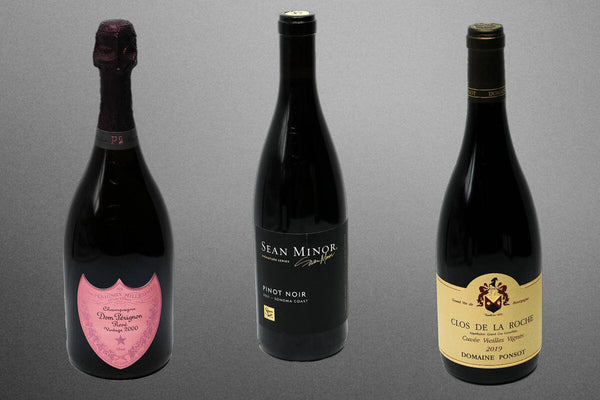Fine, Premium, and Luxury: The Categories of Wine

Let’s say you want to by a bottle of wine as a very special gift for someone close to you, maybe as a birthday gift for your brother, or as a present to impress someone, like your boss. When you go to order wine online, do you want a fine wine, a premium wine, or a luxury wine?
If you don’t understand what these categories mean, don’t worry. No one has come up with a solid definition of these terms. A research paper was recently published in the British Food Journal that states: “in the context of luxury consumption, luxury wine is very often interchangeably referred to as premium, ultra-premium, prestigious, fine or high-end. As such, academics have reached no consensus on what defines luxury wine and its differences from the above mentioned nomens.” Wow! Even people who spend huge amounts of time researching this topic have no answer.
Fine Wine
Fine wine has the longest heritage. The term has been used for centuries. “Fino” a type of dry Spanish sherry descends from this tradition of “vinos finos” or fine wines. A Fino had to count among the best examples produced in Jerez, Spain, and it offered quality and distinctiveness. When you buy wine online, Bottle Barn has a special category for “Fine and Rare” wines. It’s worth checking out.
Fine wine suggests it must be well-made; no “plonk” as the British say. A fine wine may be expensive, but not necessarily. It should express uniqueness, which in the wine world usually relates to a specific and distinguished place, or terroir. If it’s a red wine, then it should be amenable to ageing; maturation will bring out the finer aspects of the wine. A fine white wine, too, may be ageable. It certainly should not be undrinkable within a few years. Finally, vintage matters. A fine wine’s vintage will convey what happened that year during the complex interaction between vine, grape, soil, place, and climate. The winery’s capacity to make fine wine year and year is important, but so is vintage character. Each year is unique. So, expressiveness, uniqueness (a sense of distinct identity), and connection to that very important “sense of place” and time may help define “fine wine.”
Premium Wine
Premium wine is more of a modern-day marketing definition. There is the “premium category” on supermarket shelves. Generally, grocers place these wines at eye level, with the cheaper stuff lower down. The primary defining characteristic is price. One wine journalist described a new wine “with fruit from an unremarkable site, though lavished . . . with new oak. The producers used its $75 price as a positioning strategy.” That is, price is the allure when you buy wine online. “Consumers can’t taste a bottle of luxury wine . . . before they commit. Thus, they must use cues like price to infer quality and make buying decisions.” Coming from an undistinguished vineyard location, this wine thus missed the “fine wine” definition.
Premium thus comes with price definitions. The pricing bands might look like this: value wine ($4–$12), popular ($13–$16), premium ($17–22), super premium ($23–$30), ultra-premium ($30–$50), luxury ($50–$100), super luxury ($100–$200) and icon ($200 or more). As winemaking and related technology have vastly improved over the past 30 years, very few wine are technically “bad.” The price should reflect grape quality, winemaking skill, the appellation’s renown, a good vintage, the winery’s reputation, and, as the price increases, prestige.
Luxury Wine
Luxury wines are special. I recently asked French luxury wine expert Evelyn Resnick if Dom Perignon Champagne was a luxury wine. I wasn’t sure where she would come down on this issue. She said, “I would not qualify it ‘luxury’ because of the number of bottles produced (about 5 million according to some experts). Luxury is about exclusivity, scarcity and high quality. If the quality is at the top, the two other criteria (scarcity and exclusivity) are not met.” She likes Dom Perignon—" Dom Pérignon is really worth it just for giving the drinker the exceptional experience of a single vintage champagne”—but it doesn’t qualify as a luxury wine. Why?
It has the alluring high price, it’s very high quality (meticulously made from superb grapes), it conveys prestige, and it has heritage: a venerable history. These are usually key component in defining something as a luxury product. The answer: No scarcity (5 million bottles) and hence, no exclusivity. So, does all luxury have to be scarce, exclusive, and very expensive?
Not necessarily. Luxury wines can include high-quality wines expressive of place and vintage, with very limited production, and hence be very exclusive. So, there could be good value in luxury wines. Examples would include small producers in places like California’s Sonoma County or Oregon’s Willamette Valley who produce 5000 cases or less of wine a year. The best wine store USA, Bottle Barn, for example, has developed close relationships with local, small wineries producing fine wine. Owing to their scarcity, these wines may slip into the luxury category but still have a good price-to-quality ratio. These will not be cheap wines by any means, but if you look at the Sonoma County selection, for example, you may find an exclusive and scarce luxury wine for that special gift, full of distinctive character, at a good price.

















Leave a comment